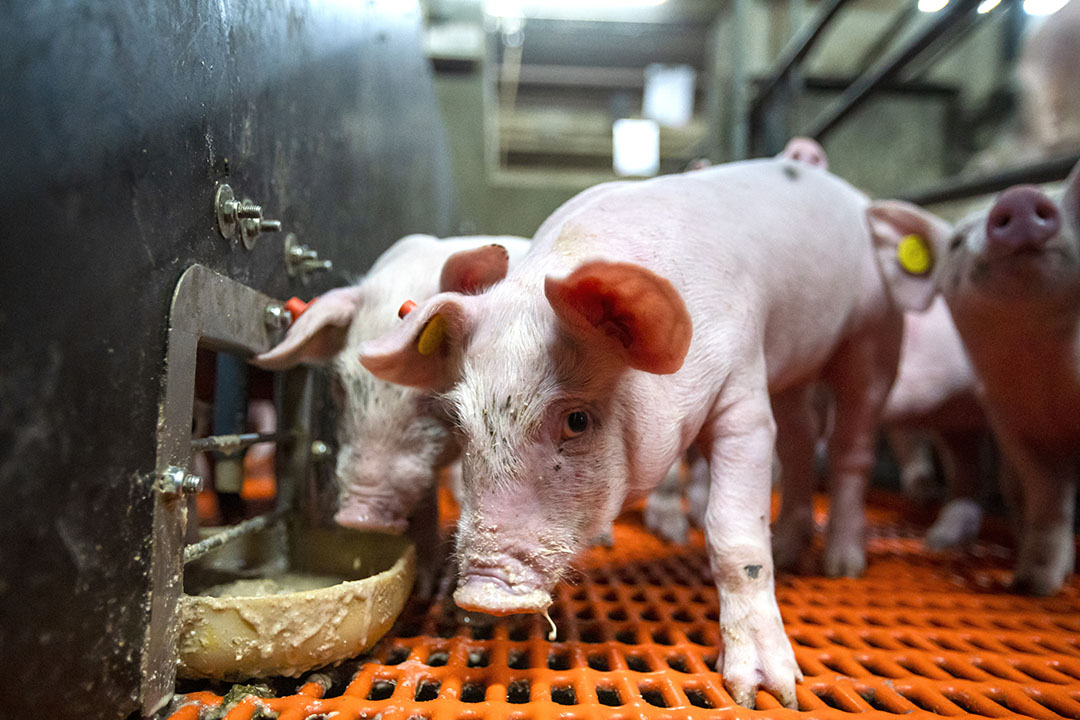Fermented feed helps piglet through weaning period

Piglets’ gastrointestinal tracts are severely tested after weaning. A large dose of lactic acid can ameliorate the effect of a weaning dip. In this article, we present an overview of fermented piglet feed.
Giving piglets fermented feed is a tried and tested method to help them get through their weaning periods in good shape. Several suppliers offer such feed.
2 options: ready-made or fermenting
There are 2 ways to approach fermented feeding:
- Sow farmers can buy a ready-made, liquid product. All they need to do then is keep the feed fresh.
- The second option is a dry grain mixture that is fermented on the farm. This is then added to the ration.
Newly weaned piglets eat very little. That’s why feeding fermented feed is possible on both liquid and dry feed farms, even when this has to be done manually. Feeding fermented feed on farms that use liquid feed is, of course, easier, both technically and from the perspective of the piglet. It requires less labour and the piglets do not need to switch from liquid to dry feed 2 weeks after weaning. There are, however, plenty of dry feed farms that give their piglets fermented feed.
Lots of lactic acid bacteria
An important reason for giving piglets fermented feed while weaning is the large amount of lactic acid bacteria it contains. Lactic acid helps to reduce the stomach’s acidity. Together with gastric acid the lactic acid ensures better digestion and prevents excessive harmful E-coli and streptococcus bacteria multiplying in the large intestine. When undigested protein enters the large intestine, it creates a breeding ground for these bacteria.
Every sow farmer knows the consequences:
- weaning diarrhoea,
- oedema disease caused by coli or
- meningitis caused by streptococci.
In the first week after weaning, it is mostly E-coli that are to blame for trouble in the piglet barn. In the second and third weeks problems due to streptococcus typically occur. Another advantage of fermented feed is its taste. According to pig vet Arjan Schuttert of veterinary practice De Oosthof in the Netherlands pigs prefer acidic feed: “Commercial concentrate mix (CCM) is at the top of all pigs’ taste indexes.” Schuttert thinks that fermented pig feed has various advantages when it comes to gut health and flavour. Liquid feed is ideal because preparing and feeding fermented dry feed often requires more labour. Fermented feed is manually fed to pigs at many farms and it is advisable to do this many times a day. Automation is an option and a device made by De Heus Animal Nutrition, for example, can be linked to a piglet feeder such as the Nutrix+ from Weda, even though this is a somehat complex operation.
Investing up to € 100,000
The investment required for using fermented feed varies considerably. When it is delivered ready-made, there is no investment. But, when farmers opt for feeding liquids to all of their sows, the investment can be as high as € 100,000. This is nevertheless a responsible investment, according to ForFarmers nutritionist Bram van den Oever. He says that ForFarmers has calculated the time needed for a return on investment (ROI) is 2 years on a farm with 1,000 sows. The investment includes purchasing a dedicated mixer to ferment piglet feed on the farm, which can cost upwards of € 3,000, depending on the equipment that is already on the farm. The fermented feed price varies, as is the case with the price of other pig feed.

Agrifirm not convinced
Not all feed suppliers are convinced of the value of using fermented feed. For example, Royal Agrifirm Group does not supply fermented piglet feed, because they are not convinced of its added value. AgruniekRijnvallei, a Dutch feed company, supplies pig feed with a maximum of 5% added CCM. The amount of lactic acid the piglets consume is, however, minimal. According to AgruniekRijnvallei’s product manager for pig feed Eelco van de Hoef, making sure piglets keep eating after weaning and preventing fluctuations in the feed intake is very important, as too much or too little feed intake is detrimental to piglets’ gut health.
Sound management is crucial
Piglet breeding is increasingly in the spotlight. Litter sizes are growing and legislation is becoming more stringent. Since mid-August, for example, piglet feed has to contain less copper. A ban on the use of zinc oxide, due to its negative impact on the environment, will come into effect in June, 2022 and antibiotics have been off the menu for many years. Leaving out these veterinary aids has to be compensated, e.g. with luxury feed, (organic) acids and more attentive management, for example, feeding pigs many times a day and making sure they are in a warm, dry barn after weaning. That is why administering fermented feed or fibre, to prevent it being digested too rapidly, is on pig farmers’ radars. However, when piglets refuse to eat the most luxury feed, nothing is gained regarding gut health. That’s why it’s important that management is perfect. Feeding needs to be hygienic, the barn’s climate optimised and clean drinking water must be available at all times, etc. When all these conditions are met, the chances are that fermented feed will have a positive effect. It can help to keep piglets’ guts healthy during the weaning period, as long as it;s good-quality feed. Liquid feed nutritionist Robin van den Berk from De Heus Animal Nutrition says: “Fermented feed is not a substitute for antibiotics.” So it can’t be the solution for all health problems in piglets.

Gut Health: Managing gut health is very complex with many parameters to consider. This section highlights specie-specific topics, including stress-related intestinal issues in weaning pigs, antibiotic alternatives to maintain poultry health and avoiding gut problems in dairy cows.











